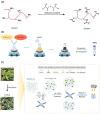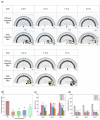A Printable Magnetic-Responsive Iron Oxide Nanoparticle (ION)-Gelatin Methacryloyl (GelMA) Ink for Soft Bioactuator/Robot Applications
- PMID: 38201691
- PMCID: PMC10780401
- DOI: 10.3390/polym16010025
A Printable Magnetic-Responsive Iron Oxide Nanoparticle (ION)-Gelatin Methacryloyl (GelMA) Ink for Soft Bioactuator/Robot Applications
Abstract
The features or actuation behaviors of nature's creatures provide concepts for the development of biomimetic soft bioactuators/robots with stimuli-responsive capabilities, design convenience, and environmental adaptivity in various fields. Mimosa pudica is a mechanically responsive plant that can convert pressure to the motion of leaves. When the leaves receive pressure, the occurrence of asymmetric turgor in the extensor and flexor sides of the pulvinus from redistributing the water in the pulvinus causes the bending of the pulvinus. Inspired by the actuation of Mimosa pudica, designing soft bioactuators can convert external stimulations to driving forces for the actuation of constructs which has been receiving increased attention and has potential applications in many fields. 4D printing technology has emerged as a new strategy for creating versatile soft bioactuators/robots by integrating printing technologies with stimuli-responsive materials. In this study, we developed a hybrid ink by combining gelatin methacryloyl (GelMA) polymers with iron oxide nanoparticles (IONs). This hybrid ION-GelMA ink exhibits tunable rheology, controllable mechanical properties, magnetic-responsive behaviors, and printability by integrating the internal metal ion-polymeric chain interactions and photo-crosslinking chemistries. This design offers the inks a dual crosslink mechanism combining the advantages of photocrosslinking and ionic crosslinking to rapidly form the construct within 60 s of UV exposure time. In addition, the magnetic-responsive actuation of ION-GelMA constructs can be regulated by different ION concentrations (0-10%). Furthermore, we used the ION-GelMA inks to fabricate a Mimosa pudica-like soft bioactuator through a mold casting method and a direct-ink-writing (DIW) printing technology. Obviously, the pinnule leaf structure of printed constructs presents a continuous reversible shape transformation in an air phase without any liquid as a medium, which can mimic the motion characteristics of natural creatures. At the same time, compared to the model casting process, the DIW printed bioactuators show a more refined and biomimetic transformation shape that closely resembles the movement of the pinnule leaf of Mimosa pudica in response to stimulation. Overall, this study indicates the proof of concept and the potential prospect of magnetic-responsive ION-GelMA inks for the rapid prototyping of biomimetic soft bioactuators/robots with untethered non-contact magneto-actuations.
Keywords: DIW printing; gelatin methacryloyl (GelMA); iron oxide nanoparticles (IONs); magnetic-responsive materials; soft bioactuators/robots.
Conflict of interest statement
The authors declare no conflict of interest.
Figures





Similar articles
-
A self-healing hydrogel and injectable cryogel of gelatin methacryloyl-polyurethane double network for 3D printing.Acta Biomater. 2023 Jul 1;164:124-138. doi: 10.1016/j.actbio.2023.04.023. Epub 2023 Apr 22. Acta Biomater. 2023. PMID: 37088162
-
Hierarchical biomaterials via photopatterning-enhanced direct ink writing.Biofabrication. 2021 Sep 9;13(4). doi: 10.1088/1758-5090/ac212f. Biofabrication. 2021. PMID: 34433148
-
Enhanced Electroactivity, Mechanical Properties, and Printability through the Addition of Graphene Oxide to Photo-Cross-linkable Gelatin Methacryloyl Hydrogel.ACS Biomater Sci Eng. 2021 Jun 14;7(6):2279-2295. doi: 10.1021/acsbiomaterials.0c01734. Epub 2021 May 6. ACS Biomater Sci Eng. 2021. PMID: 33956434
-
Composite Inks for Extrusion Printing of Biological and Biomedical Constructs.ACS Biomater Sci Eng. 2021 Sep 13;7(9):4009-4026. doi: 10.1021/acsbiomaterials.0c01158. Epub 2020 Nov 10. ACS Biomater Sci Eng. 2021. PMID: 34510905 Review.
-
Mechanism of the Pulvinus-Driven Leaf Movement: An Overview.Int J Mol Sci. 2024 Apr 23;25(9):4582. doi: 10.3390/ijms25094582. Int J Mol Sci. 2024. PMID: 38731801 Free PMC article. Review.
References
-
- Cianchetti M., Laschi C., Menciassi A., Dario P. Biomedical applications of soft robotics. Nat. Rev. Mater. 2018;3:143–153. doi: 10.1038/s41578-018-0022-y. - DOI
Grants and funding
- MOST 109-2221-E-035-007-MY3/National Science and Technology Council, Taiwan
- MOST 109-2221-E-035-036-MY3/National Science and Technology Council, Taiwan
- MOST 110-2124-M-005-001-MY3/National Science and Technology Council, Taiwan
- NSTC 112-2221-E-035-006-MY3/National Science and Technology Council, Taiwan
LinkOut - more resources
Full Text Sources

